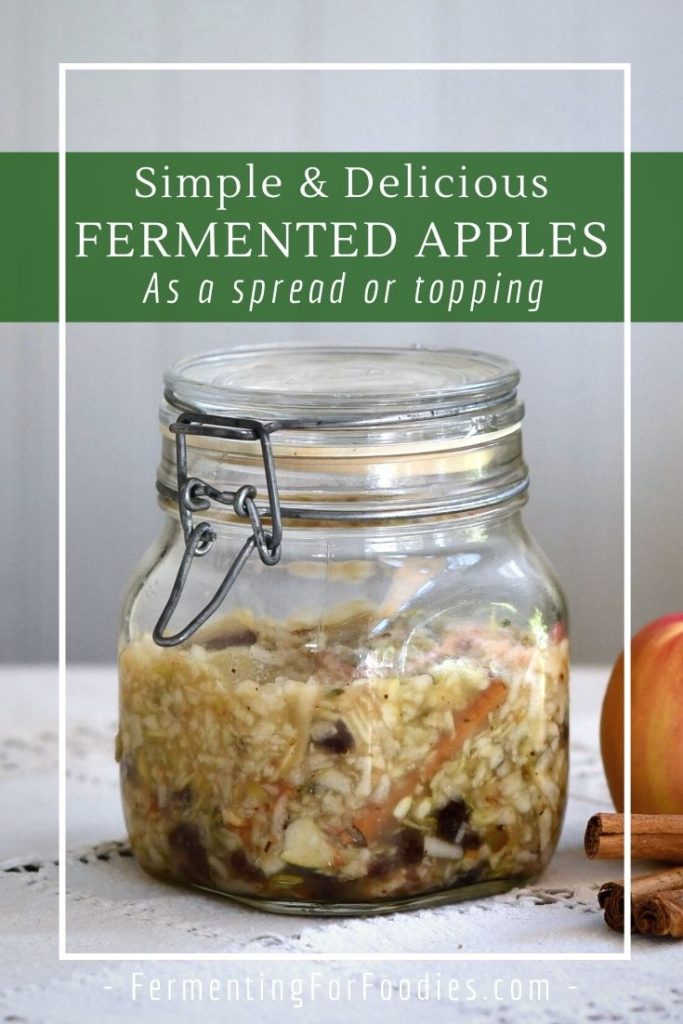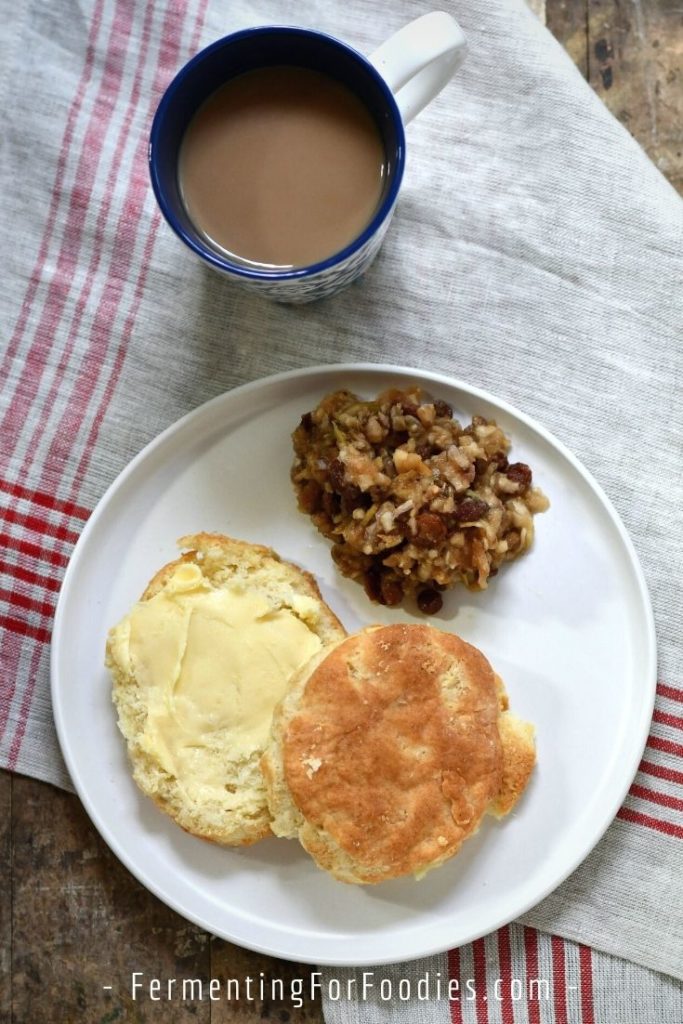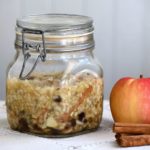
This fresh and brightly flavored fermented apple spread is a versatile and delicious condiment. Sweetened with raisins and a mix of spices, it is perfect spread on a slice of toast or served with cheese.
Using fermentation means that this is a super easy, no-cooking way to preserve apples. See the section below for 3 ways to store this apple spread for several months.
Serving Options
This fermented apple spread is so flavorful and delicious. There are so many different ways to enjoy it.
- With cheese: Fermented apple spread is delicious with cheese. Try serving it as part of an appy platter or a charcouterie board.
- Topping: Serve it as an apple pie flavoured topping for yogurt, oatmeal, pancakes or waffles. It’s not very sweet, so feel free to add in a bit of extra sweetener.
- Spread: Fermented apples and raisins become really soft. Just like apple butter, it can be spread on a slice of toast. For a smooth spread, leave out the walnuts.
- Sandwiches: Max loves this spread on peanut butter sandwiches. He likes it so much that he’ll turn down jam in favor of a big dollop of fermented apples.
- Chutney: This recipe was based on an apple chutney recipe. While the original version involved cayenne pepper, this is delicious as a not-spicy chutney. Serve it with pakoras, roti or other Indian dishes.
Long Term Storage of Fermented Apples
We usually make fermented apples in the fall, when our local apple crop comes in and we have way more apples than we can eat.
After making apple sauce, dried apple rings, and frozen apple slices, we turn to other condiments like apple chutney.
Here are a few long-term storage options, so you can enjoy fermented apples all winter long.
1. Freezer
Probably the easiest long-term storage option is to freeze the apple spread in a freezer-safe container. It should last for at least 6 months and still be probiotic!
2 Fridge
In the recipe, I’ve stated that this spread will last for 1 month in the fridge. That’s a fairly conservative estimate. I’ve actually never had a fermented condiment go off. Admittedly, we usually finish our condiments within a few months.
There are just two things to note about storing this in the fridge:
- The apples will keep fermenting. So they will be very tart if you leave them for more than a few weeks in the fridge.
- Always use a clean spoon to avoid contamination. No double-dipping!
3. Cool Dark Storage
It is possible to leave the apples to ferment for several months in a cool dark location. However, you need to be extra careful if you want to do a long-term ferment.
- Be sure to use a fermentation-specific jar that will allow gas to escape while preventing contamination. A fido jar or a mason jar with a pickle pipe are good options.
- Sanitize your jar to prevent any possible contamination.
- The spread will continue to ferment until all the sugars are gone. Expect it to be quite tart, unless you stir in a bit of extra sweetener right before serving.
- Once you’ve opened the jar, store it in the fridge.

Fermented Apple Raisin Spread
Fermented apple raisin spread is a lightly sweet and spicy condiment that tastes like apple pie. It is a delicious alternative to jam, or served with cheese. See the section above for more serving options.
- Prep Time: 20 minutes
- Total Time: 20 minutes
- Yield: 3 cups 1x
- Category: Condiment
- Method: Fermented
- Cuisine: Indian
- Diet: Vegan
Ingredients
- 1/2 cup walnuts (optional)
- 1/2 cup raisins
- 2 Tbsp sugar (to feed the ferment)
- 6 whole cloves, ground or 1/2 tsp ground cloves (see notes)
- 1 cinnamon stick (or 1/2 tsp ground cinnamon)
- 1/2 tsp fennel seed
- 2 cups of grated apple (about 2 medium apples)
- 1/4 cup yeast-based culture (see notes for details)
- 1/4 cup filtered water
Instructions
- The walnuts add a nutty crunch to this otherwise smooth spread. They are completely optional. If you decide to include walnuts, toast them lightly, then finely chop.
- Place the walnuts, raisins, sugar, and spices in a quart-sized jar (1 L).
- Add half of the apple to the jar, stir to mix it with the spices. Then add the rest of the apple with the culture, and water stir again.
- Pack everything down into the jar. The apple may not be completely submerged in liquid, however, it will soften and release liquid as it ferments, so don’t worry.
- Add in the cinnamon stick, pushing it down into the center of the apple mixture.
- Ferment in a cool dark location for 2-3 days.
- Cap with an air-tight lid and store in the fridge. Use within 1 month. See the section above for other storage options.
- The added sugar is used to feed the ferment. So the spread will be more tart than sweet. If you would like it to be a bit sweeter, feel free to stir in a bit of sugar or honey (around 2 Tbsp) right before serving.
Notes
- There are a number of options for a yeast-based starter. Probiotic beverages, like kombucha or water kefir, are a great starter for this ferment. I really like the added flavor that comes with using ginger bug. Store-bought starters include unpasteurized apple cider vinegar or raw honey. Please note that honey-based ferments are not recommended for pregnant women, children under the age of 1 year, or anyone who may be immunocompromised.
- This spread will be sparkling right after fermentation, however, that should decrease after a few days in the fridge.
- Freshly ground cloves pack a lot more flavor than store-bought ground cloves. So grinding your own cloves will actually require less than 1/2 tsp ground.




I dont think mine fermented. Granted im new to fermenting so im hoping to get some tips.
I omitted the nuts (allergy) and fennel seed, used “Pink Lady Apple Kombucha by Health-Ade” for the yeast based culture. I opted for the ground spices, used well water & pickle pipe lids. Let it sit in dark pantry for 3 days. Per your notes it should be more tart than sweet. Mine is the opposite. Any suggestions? Can this be left to ferment longer?
Hum, I’ve never heard of that product. So I did a quick google search and I’m still not sure if it’s as live probiotic as they claim. The website says that the drink can be stored at room temperature… which tells me that it’s not teaming with a yeast-based culture typically found in kombucha. Otherwise, the bottles would continue to ferment until they were extremely carbonated and potentially burst. So perhaps that’s why it didn’t work as a culture for this ferment? If it’s too sweet for you, then maybe try adding a bit of ACV for culture and letting it ferment for a few more days. However, I don’t think that the kombucha beverage has the culture necessary for this ferment. Good luck! Emillie
Thank you. For one batch/recipe how much ACV do you suggest?
Since it hasn’t fermented, try using the full 1/4 cup. Good luck!
This is amazing! I eat it on toast for breakfast!
Sounds delicious. Enjoy!
Since I don’t have a pickle pipe jar, should I open the jar occassionally to allow the gas to escape? If so, how often?
Hi Beth, When I run out of fermenting jars, I pack my ferments into regular jars. However, it’s important to either open the lid daily to release the CO2. Or I usually just don’t tighten the lid in the first place. A loose lid on top of a jar does a pretty good job of keeping out contaminants while letting CO2 escape. If possible, use a weight to keep everything under the liquid as it ferments. You don’t need to have specialty weights. A smaller jar filled with water works well too. Cheers! Emillie
Hi, as a yeast-based starter, can I use kefir whey?
Thanks!
Stefano
Absolutely! Enjoy!